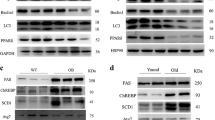Abstract
The first peroxisome proliferator-activated receptor (PPAR) was cloned in 1990 by Issemann and Green. Many studies have reported the importance of this receptor in the control of gene expression of enzymes involved in lipid metabolic pathways including mitochondrial and peroxisomal fatty acid β-oxidation, lipoprotein structure [apolipoprotein (apo) A2, apo Clll], and fatty acid synthase. By using radiolabeled molecules, it was shown that peroxisome proliferators bind and activate PPAR. As an alternative method, we developed a fluorescent dansyl (1-dimethyl-aminonaphthalene-5-sulfonyl) derivative peroxisome proliferator from bezafibrate (DNS-X), a hypolipidemic agent that exhibits an in vitro peroxisome proliferative activity on rat Fao-hepatic derived cultured cells. However, until now, the effect of this new compound on the liver of animals and subcellular localization was unknown. In addition to in vivo rat studies, we present a more efficient large-scale technique of DNS-X purification. Treating rats (DNS-X in the diet at 0.3% w/w) for 6 d leads to a hepatomegaly and a marked increase in liver peroxisomal palmitoyl-CoA oxidase activity. We also developed a method to localize and quantify DNS-X in tissues or cell compartment organelles. The primarily cytosolic distribution of DNS-X was confirmed by direct visualization using fluorescence microscopy of cultured Fao cells. Finally, transfection assay demonstrated that DNS-X enhanced the PPARα activity as well as other peroxisome proliferators do.
Similar content being viewed by others
Abbreviations
- Bezafibrate:
-
2-{4-[2-(4-chlorobenzamido)ethyl]phenoxy}-2-methylpropanoic acid
- DNS-Cl:
-
5-(dimethylamino)naphthalene-1-sulfonylchloride, or dansyl chloride
- DNS-OH:
-
5-(dimethylamino)naphthalene-1-sulfonic acid
- DNS-Phe:
-
Dansyl phenylalanine
- DNS-X:
-
2-[4-(N-dansyl-2-aminoethyl)phenoxy]-2-methylpropanoic acid
- Fao cells:
-
a rat hepatoma-derived cell line
- HPLC:
-
High-performance liquid chromatography
- PBS:
-
phosphate-buffered saline
- PP:
-
peroxisome proliferator
- PPARα:
-
peroxisome proliferator-activated receptor α
- PPRE:
-
peroxisome proliferator response element
- RP-HPLC:
-
reversed-phase HPLC
- TLC:
-
thin-layer chromatography
References
Green, S. (1992) Receptor Mediated Mechanisms of Peroxisome Proliferators, Biochem. Pharmacol. 43, 393–401.
Latruffe, N., Vamecq, J. (1999) Medical Significance of Peroxisome Proliferators-Activated Receptors, Lancet 354, 141–148.
Passilly, P., Jannin, B., and Latruffe, N. (1995) Influence of Peroxisome Proliferators on Phosphoprotein Levels in Human and Rat Hepatic-Derived Cell Lines, Eur. J. Biochem. 230, 316–321.
Motojima, K. (1993) Peroxisome Proliferator-Activated Receptor (PPAR): Structure, Mechanisms of Activation and Diverse Functions, Cell. Struct. Funct. 18, 267–277.
Berlot, J.P., Grub, S., Duclos, C., Causeret, C., Tainturier, G., and Latruffe, N. (1997) Preparation of a Dansylated Fibrate, a New Fluorescent Tool to Study Peroxisome Proliferation. Effect on Hepatic Derived Cell Lines, Biochimie 79, 145–150.
Vamecq, J. (1990) Fluorometric Assay of Peroxisomal Oxidases, Anal. Biochem. 186, 340–349.
Gray, W.R. (1970) End-Group Analysis Using Dansyl Chloride, Methods Enzymol. 55, 121–138.
Bardot, O., Aldridge, T.C., Latruffe, N., and Green, S. (1993) PPAR-RXR Heterodimer Activates a Peroxisome Proliferator Response Element Upstream of the Bifunctional Enzyme Gene, Biochem. Biophys. Res. Commun. 192, 37–45.
de Duve, C., Pressman, B.C., Gianeto, R., Wattiaux, R., Appelmans, F. (1995) Tissue Fractionation Studies 6. Intracellular Distribution Pattern of Enzymes in Rat Liver Tissue, Biochem. J. 60, 604–617.
Ghosh, M.K., and Hajra, A.K. (1986) A Rapid Method for Isolation of Peroxisomes from rat Liver, Anal. Biochem. 159, 167–174.
El Kebbaj, M.S., Cherkaoui Malki, M., Latruffe, N. (1996) Properties of Peroxisomes from Jerboa (Jaculus orientalis), Eur. J. Cell Biol. 70, 150–156.
Cherkaoui Malki, M., Bardot, O., Lhuguenot, J.C., Latruffe, N. (1990) Expression of Liver Peroxisomal Proteins as Compared to Other Organelle Marker Enzymes in Rats Treated with Hypolipidemic Agents, Biol. Cell 69, 83–92.
Bradford, M. (1976) A Rapid and Sensitive Method for the Quantitation of Microgram Quantities of Protein Utilizing the Principle of Protein Dye Binding, Anal Biochem. 73, 248–254.
Brocard, C., Ramirez, L.C., and Bournot, P. (1994) Fao Cell Line as a Model for the Study of the Effect of Peroxisome Proliferators on Cellular Functons, in Peroxisomes (Latruffe, N., and Bugaut, A., eds.), pp. 177–179, Springer-Verlag, Berlin.
Sher, T., Yi, H., McBride, W., and Gonzalez, F.J. (1993) cDNA Cloning, Chromosomal Mapping and Functional Characterization of a Human PPARα, Biochemistry 32, 5598–5604.
Motojima, K., Passilly, P., Peters, J.M., Gonzalez, F.J., and Latruffe, N. (1998) Expression of Putative Fatty Acid Transporters Genes Are Regulated by PPARα and γ Activators in a Tissue- and Inducer-Specific Manner, J. Biol. Chem. 273, 16710–16714.
Bardot, O., Clemencet, M.C., Passily, P., and Latruffe, N. (1995) The Analysis of Modified Peroxisome Proliferator Responsive Elements of the Peroxisomal Bifunctional Enzyme in Transfected HepG2 Reveals Two Regulatory Motifs, FEBS Lett. 360, 183–186.
Lock, E.A., Mitchell, A.M., and Elcombe, C.R. (1989) Biochemical Mechanisms of Induction of Hepatic Peroxisome Proliferation, Annu. Rev. Pharmacol. Toxicol. 29, 145–163.
Lalwani, N.D., Alvares, K., Reddy, M.K., Reddy, M.N., Parikh, I., and Reddy, J.K. (1987) Peroxisome Proliferator-Binding Protein: Identification and Partial Characterization of Nanofepin-, Clofibric Acid-, and Ciprofibrate-Binding Proteins from Rat Liver, Proc. Natl. Acad. Sci. USA 84, 5242–5246.
Alvares, K., Alejandro, C., Yuan, P.M., Kawano, H., Morimoto, R.L., and Reddy, J.K. (1990) Identification of Cytosolic Peroxisome Proliferator Binding Protein as a Member of the Heat Shock Protein HSP-70 Family, Proc. Natl. Acad. Sci. USA 87, 5293–5297.
Sugiyama, H., Yamada, J., Takama, H., Kodama, Y., Watanabe, T., Taguchi, T., and Suga, T. (1997) Photoaffinity Labeling of Peroxisome Proliferator Binding Proteins in rat Hepatocytes; Dehydroepiandrosterone Sulfate- and Bezafibrate-Binding Proteins, Biochim. Biophys. Acta. 1339, 321–330.
Momose, Y., and Nagata, T. (1993) Radioautographic Study on the Intracellular Localization of a Hypolipidemic Agent, Bezafibrate, a Peroxisome Proliferator, in Cultured Rat Hepatocytes, Cell. Mol. Biol. 39, 773–781.
Author information
Authors and Affiliations
Corresponding author
About this article
Cite this article
Berlot, JP., Lutz, T., Malki, M.C. et al. Properties of a fluorescent bezafibrate derivative (DNS-X). A new tool to study peroxisome proliferation and fatty acid β-oxidation. Lipids 35, 1397–1404 (2000). https://doi.org/10.1007/s11745-000-0657-0
Received:
Revised:
Accepted:
Issue Date:
DOI: https://doi.org/10.1007/s11745-000-0657-0




